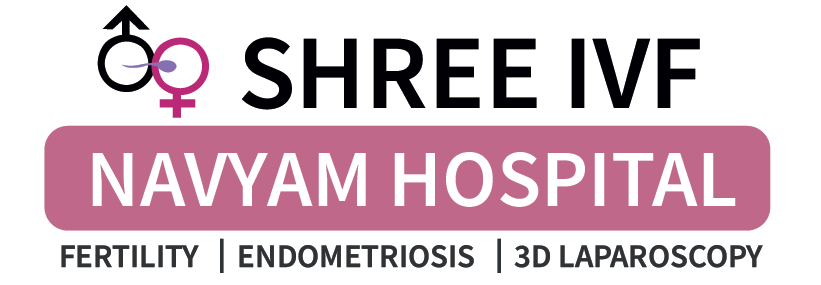
Endometriosis, particularly Deep Endometriosis, is a common gynecological condition that can cause severe pain and fertility issues in women.One form of this disease, Focal Adenomyosis of Outer Myometrium (FAOM), has recently been drawing attention for its connection with Deep Endometriosis.
🌸 Understanding Deep Endometriosis: Causes, Symptoms, Diagnosis, and Treatment
Deep Endometriosis is a severe form of endometriosis where the endometrial-like tissue grows deep into the tissues surrounding the pelvic organs. Unlike superficial endometriosis, which affects only the surface layers, deep endometriosis penetrates 5 mm or more into the tissues, often causing intense pain, inflammation, and scarring. It can involve the bowel, bladder, uterus, ovaries, vagina, and even nearby nerves, significantly impacting fertility and quality of life.
✅ What Is Deep Endometriosis?
Deep endometriosis is a complex and invasive form of the condition where endometrial-like tissue grows extensively into the pelvic structures. It differs from typical endometriosis in the following ways:
- It invades deeper layers of tissue, sometimes infiltrating organs.
- Often causes more intense pain and fertility issues.
- More challenging to diagnose and treat due to its complexity.
🔍 Symptoms of Deep Endometriosis
The symptoms of deep endometriosis vary based on the organs affected. Common symptoms include:
- Severe pelvic pain: Intense menstrual cramps and chronic pelvic pain.
- Painful intercourse (dyspareunia): Pain during or after sexual activity.
- Heavy or irregular periods: Prolonged menstrual bleeding.
- Gastrointestinal symptoms: Pain during bowel movements, constipation, or diarrhea (if the bowel is involved).
- Urinary issues: Painful urination or blood in urine (if the bladder is affected).
- Infertility: Difficulty in conceiving due to scarring and inflammation.
- Back and leg pain: If the sciatic nerve is involved.
🔬 Causes and Risk Factors
The exact cause of deep endometriosis is not fully understood, but the following factors may contribute:
✅ Retrograde Menstruation:
- Menstrual blood flows backward into the pelvic cavity, allowing endometrial cells to implant and grow.
✅ Hormonal Imbalance:
- High estrogen levels can stimulate the abnormal growth of endometrial tissue.
✅ Immune System Dysfunction:
- The immune system fails to recognize and eliminate misplaced endometrial cells.
✅ Genetic Predisposition:
- Women with a family history of endometriosis are at a higher risk.
✅ Surgical Procedures:
- Previous pelvic surgeries (e.g., C-sections) can displace endometrial cells, leading to deep infiltrating endometriosis.
🔎 Diagnosis of Deep Endometriosis
Diagnosing deep endometriosis can be challenging due to its complexity. The following diagnostic methods are commonly used:
✅ Pelvic Examination:
- Doctors may detect nodules or tenderness during a manual pelvic exam.
✅ Transvaginal Ultrasound (TVUS):
- Uses sound waves to visualize the ovaries, uterus, and deep lesions.
- Effective in detecting deep infiltrating endometriosis.
✅ Magnetic Resonance Imaging (MRI):
- Provides detailed images of the pelvic structures and can identify the extent of endometriosis.
✅ Laparoscopy:
- Minimally invasive surgery where a small camera is inserted into the abdomen.
- Confirms the diagnosis and allows for surgical removal of endometriotic lesions.
🌟 Deep Endometriosis and Affected Organs
1. Deep Bowel Endometriosis
When endometrial-like tissue infiltrates the bowel wall, it causes:
- Painful bowel movements during menstruation.
- Constipation or diarrhea.
- Bloating and rectal bleeding during periods.
✅ Treatment Options:
- Laparoscopic surgery: To remove bowel lesions while preserving healthy tissue.
- Hormonal therapy: To suppress the growth of endometrial tissue.
- Bowel resection surgery: In severe cases, a portion of the bowel may be removed.
2. Deep Bladder Endometriosis
When endometrial tissue infiltrates the bladder, it causes:
- Frequent urination and urgency.
- Blood in urine during menstruation.
- Bladder pain and discomfort.
✅ Treatment Options:
- Cystoscopy: To examine the bladder lining.
- Laparoscopic excision surgery: To remove endometrial implants.
- Hormonal therapy: To reduce symptoms and slow progression.
3. Deep Uterine Endometriosis
Endometriosis can invade the muscle layer of the uterus, causing:
- Severe menstrual cramps (dysmenorrhea).
- Heavy menstrual bleeding (menorrhagia).
- Chronic pelvic pain.
✅ Treatment Options:
- Hormone therapy: Birth control pills, progestin, or GnRH agonists.
- Minimally invasive surgery: To remove endometrial implants.
- Hysterectomy: In severe cases, removal of the uterus.
4. Deep Nerve Endometriosis
When endometriosis affects pelvic nerves, it causes:
- Chronic lower back pain.
- Sciatic nerve pain (radiating leg pain).
- Pelvic numbness or weakness.
✅ Treatment Options:
- Laparoscopic nerve-sparing surgery: To remove deep nerve endometriosis while preserving nerve function.
- Physical therapy and pain management: To reduce nerve-related pain.
🌿 Treatment Options for Deep Endometriosis
1. Hormonal Therapy
✅ Purpose: Reduces pain and slows endometriotic tissue growth.
- Birth Control Pills: Regulate hormone levels and reduce pain.
- Progestin Therapy: Slows the growth of endometrial implants.
- Gonadotropin-Releasing Hormone (GnRH) Agonists: Induce a temporary menopausal state to shrink endometrial tissue.
- Aromatase Inhibitors: Reduce estrogen production.
2. Minimally Invasive Surgery
✅ Laparoscopic Excision Surgery:
- Removes deep endometriotic lesions while preserving fertility.
- Improves symptoms and fertility outcomes.
✅ Robotic-Assisted Surgery:
- Offers enhanced precision and minimizes damage to healthy tissue.
- Ideal for complex deep infiltrating endometriosis.
3. Pain Management
✅ Medications:
- NSAIDs (Non-Steroidal Anti-Inflammatory Drugs): Reduce inflammation and pain.
- Neuromodulators: Alleviate nerve-related pain.
- Opioids: For severe, chronic pain (used cautiously).
✅ Physical Therapy:
- Relieves pelvic muscle tension.
- Improves mobility and reduces pain.
4. Fertility Preservation and Assisted Reproductive Techniques
Women with deep endometriosis struggling with infertility may consider:
- In-Vitro Fertilization (IVF):
- Helps bypass pelvic adhesions and scarring.
- Oocyte or embryo freezing:
- Preserves fertility before aggressive treatment.
🌿 Lifestyle Tips for Managing Deep Endometriosis
✅ Anti-inflammatory Diet:
- Include omega-3-rich foods (fish, flaxseeds) and green leafy vegetables.
- Avoid processed foods, refined sugar, and caffeine.
✅ Stress Management:
- Practice yoga, meditation, and breathing exercises.
- Reduces cortisol levels, which can trigger inflammation.
✅ Regular Exercise:
- Improves blood flow and reduces inflammation.
- Eases pelvic pain.
💡 Key Takeaway
Deep endometriosis is a complex and invasive condition that significantly impacts a woman’s quality of life and fertility. Early diagnosis, personalized treatment plans, and ongoing management are crucial for improving symptoms and preserving reproductive health.
For women seeking fertility preservation, assisted reproductive technologies (ART) and minimally invasive surgeries offer hope. With proper medical care, lifestyle modifications, and pain management, women with deep endometriosis can lead healthier and more comfortable lives. 🌷


